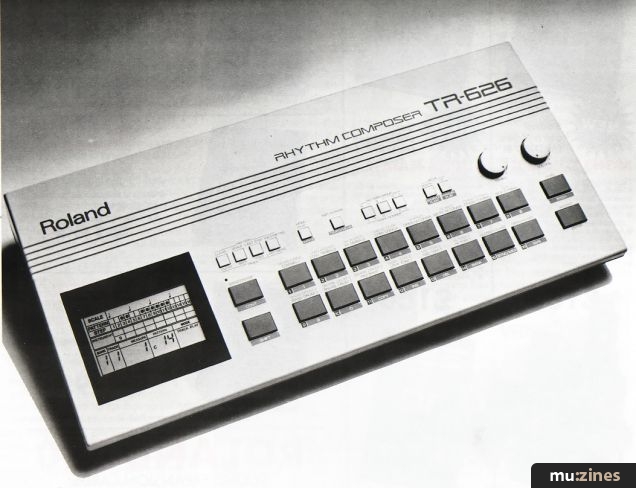Magazine Archive
Home -> Magazines -> Issues -> Articles in this issue -> View
Article Group: | |
Roland TR626 Drums | |
Article from Making Music, December 1987 | |

WE SAY
The son of the 505 (for it is he) shows that sometimes you or I can be as clever as Roland technicians. The single most common customisation to the 505 - individual outputs - makes it officially to the 626 (see spec for the listing). Hurrah.
I reckon one reason Roland drum machines do so well against their rivals is the clarity of the programming. The integral LED display shows each sound you've selected, each function you're changing and every beat you've programmed, all inside a 16 beat grid. It's here on the 626 (as on previous models) and continues to be the best.
Elsewhere revamps of the 505 are more cautious. You can tune the pitch of each digitally sampled drum over a 15 step range — eminently useful — but can't store a different 'kit' of tunings for each pattern, as you can on the Kawai R50. The accent can be fixed at different levels and programmed to fall on particular beats. And though the overall level of each drum can be fixed, there's no dynamic programming of the drums, except over MIDI with a separate sequencer.
Barring the open and closed hi-hats you now get two sounds on each of the 16 pads, (30 sounds in all) toggled back and forth using an instrument change key. You can use all 30 sounds within a pattern, but not two sounds from the same pad falling on the same beat.
If you're combining patterns into song arrangements, the total memory space is 999 bars spread across six tracks; an intelligent system as you can barter memory, deleting an old song you no longer need to provide more space in the one you're writing. Calling up bar numbers will move you swiftly around arrangements (but tax the brain if you're unsure whether it's 184 or 185). Last Measure gets you straight to the end of what you've written so far.
Sounds. Two bass drums (one tight and crisp, the other rounder and thuddier), three snares (normal, military and gated), and a choice of three single or three double headed toms complete the essential line up. The latin bits are crisp, clear and short enough not to make too many demands on the sampling memory, but the China and Crash cymbals couldn't be pulled far outside of their normal pitch without becoming grainy. Liked the choice of cup or rim on the ride cymbal.
What else we got? Full MIDI, versatile chaining systems to link adjacent patterns without going through the process of writing a track, and a MIDI sync code to sling down on tape, even more important these days, I'd suspect when you've got the individual outputs to eq, treat, and otherwise fiddle with.
Still the easiest drum machines to program, a lot of sounds made available at a low price and the individual outs are a home recordist's dream. If I have a complaint it's that the improvements Roland have made aren't as radical as I would have expected — dynamic programming, multiple readouts (being able to play two or three toms on a single beat, the 626 will only manage one) and between pattern pitch changes would doubtless have defeated Roland's intent to bring the 626 in at the price they have. The 505 was a true ground breaker. The 626 is a worthy follower, but not a genius.
ROLAND TR 626 DIGITAL DRUM MACHINE £350
Roland UK, 983 Gt West Rd, Brentford, Middx.
THEY SAY
PRESET PATTERNS 48
USER PATTERNS 48
TRACKS 6 (999 bars total)
ACCENT 7 levels
PITCH 15 levels
DRUM VOLUME 6 levels
OUTPUTS 8 individual. Bass drums, snares+rim shot, low toms, mid toms, hi toms, hi-hats, crash cymbals, ride cymbals plus stereo pair
POWER UM3 batteries, or AC adaptor
OPTIONS Memory card with twice 626 memory. Fits in rear panel slot.
MEASUREMENTS 400 (W) x 194 (d) x 55 (H) mm. 1.3kg.
Also featuring gear in this article
Roland TR626 - Rhythm Composer
(SOS Nov 87)
Roland TR626 - Rhythm Composer
(MT Nov 87)
Browse category: Drum Machine > Roland
Publisher: Making Music - Track Record Publishing Ltd, Nexus Media Ltd.
The current copyright owner/s of this content may differ from the originally published copyright notice.
More details on copyright ownership...
News and Reviews
Review by Paul Colbert
Help Support The Things You Love
mu:zines is the result of thousands of hours of effort, and will require many thousands more going forward to reach our goals of getting all this content online.
If you value this resource, you can support this project - it really helps!
Donations for May 2024
Issues donated this month: 0
New issues that have been donated or scanned for us this month.
Funds donated this month: £0.00
All donations and support are gratefully appreciated - thank you.
Magazines Needed - Can You Help?
Do you have any of these magazine issues?
If so, and you can donate, lend or scan them to help complete our archive, please get in touch via the Contribute page - thanks!






